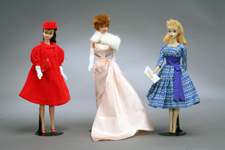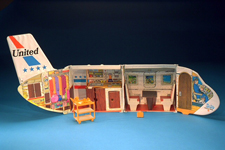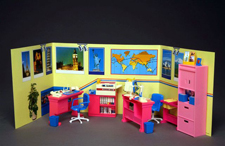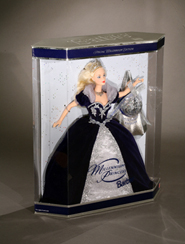| |
| |

Barbie had a wardrobe of stylish, sophisticated clothing, early 1960s.
|
Barbie turned playtime upside down for little girls when she debuted in March 1959. Previous doll play had involved nurturing baby dolls or befriending childlike companion dolls. Barbie play was entirely different.
Barbie, a teenage fashion model, had an alluring lifestyle that included shopping for the latest fashions, attending social events, driving sports cars and going out on dates. Nobody had more stylish clothes than Barbie. Her enviable wardrobe and accessories—and the lifestyle of carefree consumption and freedom she represented—were enormously appealing to the young girls who played with her. |
| |
|

Barbie Dream House, 1962. ID.2000.51.1
|
Introduced in 1962, the Barbie Dream House was a perfect backdrop for Barbie’s lifestyle of leisure and her stylish, up-to-date goods. The house was filled with sleek, modern furniture that included a combination television/stereo console. While relaxing in her very own place, Barbie could watch herself on television or listen to record albums by Nat King Cole, Frank Sinatra or the Lettermen. The Barbie Dream House also had a closet to display her array of fashionable clothing.
In the past, doll-sized play houses like this one had helped teach young girls to be good homemakers. But Barbie play wasn’t about learning traditional feminine roles of wife and mother. Rather, Barbie’s Dream House represented a hoped-for future of consumerism, freedom and independence. |
| |
|

Barbie Friend Ship Play Set, 1972-1974 ID.2000.89.4
|
This Barbie Friend Ship airplane from the 1970s offered Barbie the opportunity to participate in what was then a traditional female occupation, that of stewardess. Or Barbie might have enjoyed a pleasant flight as passenger. But at least one child used the Barbie Friend Ship in a way unintended by the manufacturer--and reflective of current events.
In the early 1970s, a number of prominent aircraft hijacking cases became well publicized in the media. Eleven-year-old Susan Bartholomew of Sandusky, Ohio, imagined a far different scenario for her Barbie play with the Friend Ship, one that involved hijacking. |
| |
|

Barbie Travel Agent set, 1986 ID.89.122.1
|
The influence of the Feminist Movement of the 1970s expanded Barbie’s identity from carefree teen model to working woman. No longer did she merely indulge in a life of leisure, socializing and fashion. Barbie now dabbled in a variety of glamorous or interesting occupations, like this 1986 Barbie Travel Agent set. Doctor Barbie debuted two years later.
But Barbie’s occupations rarely reflected those of many working women. Instead of eking out a living in an uninspiring job, Barbie’s choices involved an array of desirable careers. |
| |
|

Millennium Princess Barbie, 1999 ID.2000.63.42.7
|
As we have marked cultural milestones over the last few decades, Barbie has been with us virtually every step of the way. For example, for the American Bicentennial celebration in 1976, Barbie dolls were included in a time capsule to be opened 100 years later.
Mattel marketed this Millennium Princess Barbie, dressed in a deep blue velvet ball gown and silver tiara, to welcome in the year 2000.
While some fretful humans worried that everything would grind to a halt at midnight because of a Y2K-related computer glitch, Barbie dressed to the nines to welcome in the new millennium. |
| |
-- Jeanine Head Miller, Curator of Domestic Life |
|
|

